Practice Reflection: Analyzing Determinants of Health (PUBH630)
VerifiedAdded on 2023/03/30
|6
|1208
|103
Report
AI Summary
This report provides a comprehensive reflection on the PUBH630 course content, focusing on the determinants of health and their implications for both past and future public health practice. It explores the key health determinants, including biological, social, economic, and environmental factors, and analyzes their impact on health inequalities and overall societal well-being. The reflection incorporates a historical perspective on the understanding of health determinants, highlighting the evolution of thought from the 19th century to the present day. Furthermore, it discusses the ethical and political debates surrounding social and behavioral determinants, emphasizing the importance of intersectoral action involving government, healthcare, and community stakeholders to address health determinants effectively. The report concludes by underscoring the individual and collective responsibilities in managing and controlling health issues related to the environment and promoting a healthier society.
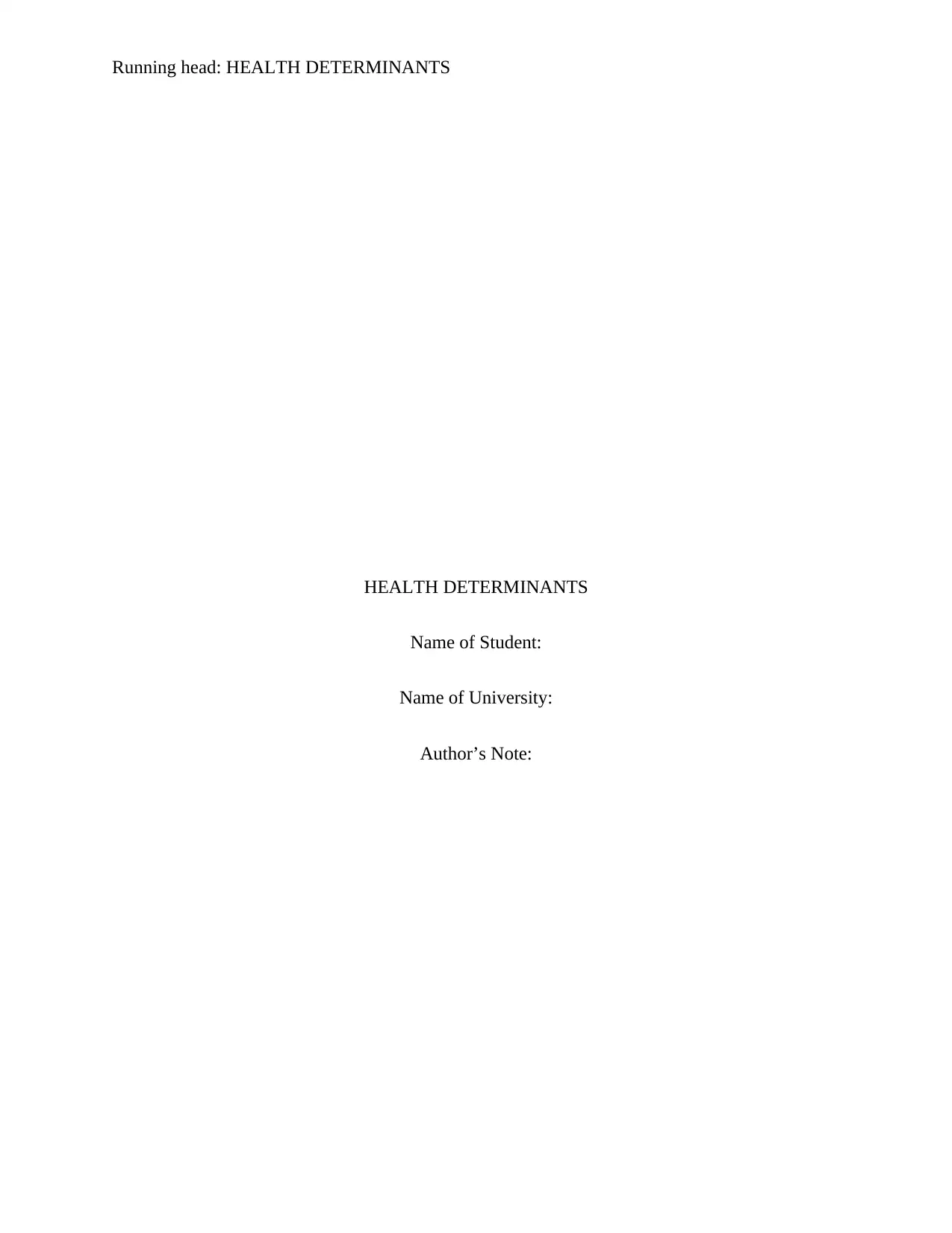
Running head: HEALTH DETERMINANTS
HEALTH DETERMINANTS
Name of Student:
Name of University:
Author’s Note:
HEALTH DETERMINANTS
Name of Student:
Name of University:
Author’s Note:
Paraphrase This Document
Need a fresh take? Get an instant paraphrase of this document with our AI Paraphraser
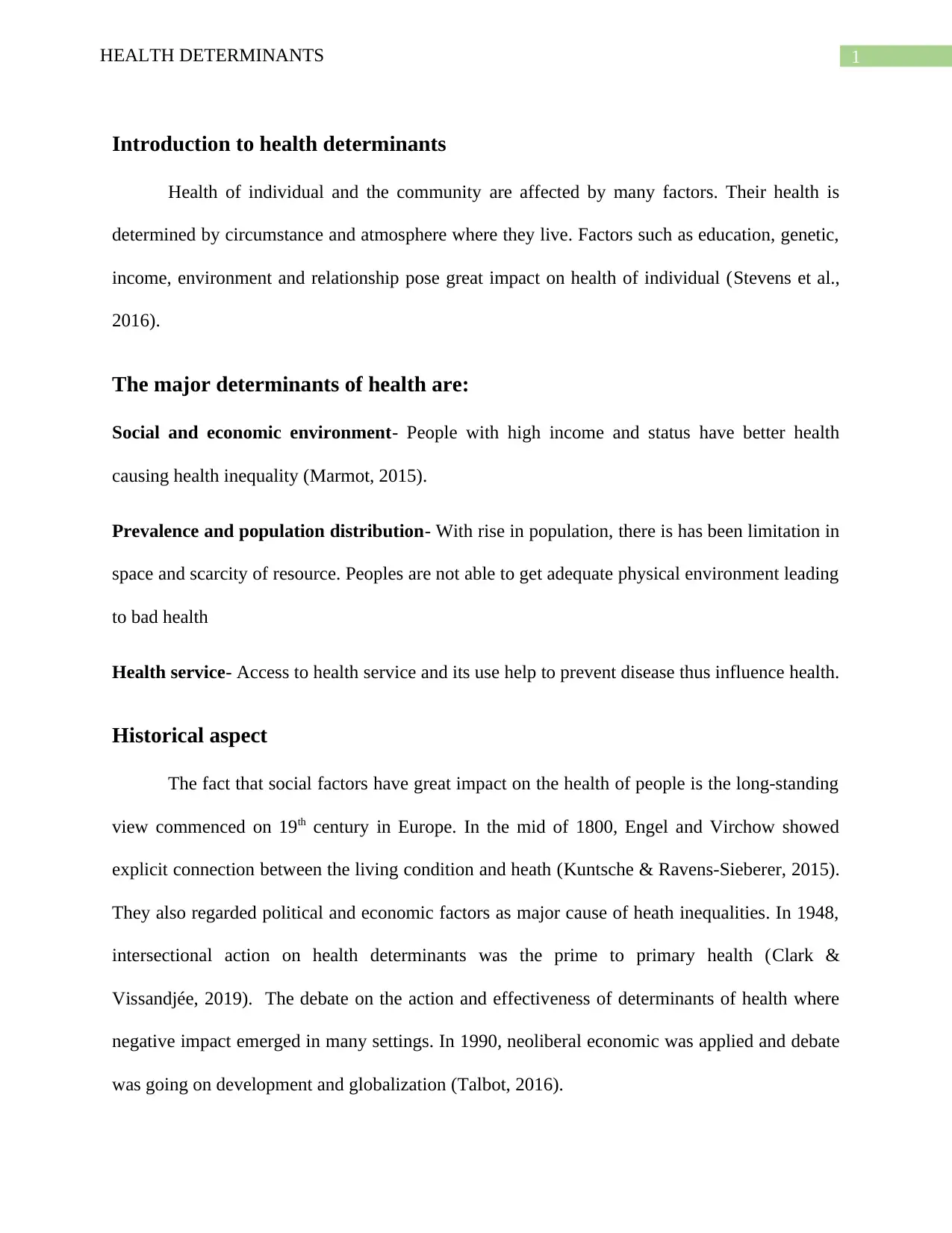
1HEALTH DETERMINANTS
Introduction to health determinants
Health of individual and the community are affected by many factors. Their health is
determined by circumstance and atmosphere where they live. Factors such as education, genetic,
income, environment and relationship pose great impact on health of individual (Stevens et al.,
2016).
The major determinants of health are:
Social and economic environment- People with high income and status have better health
causing health inequality (Marmot, 2015).
Prevalence and population distribution- With rise in population, there is has been limitation in
space and scarcity of resource. Peoples are not able to get adequate physical environment leading
to bad health
Health service- Access to health service and its use help to prevent disease thus influence health.
Historical aspect
The fact that social factors have great impact on the health of people is the long-standing
view commenced on 19th century in Europe. In the mid of 1800, Engel and Virchow showed
explicit connection between the living condition and heath (Kuntsche & Ravens-Sieberer, 2015).
They also regarded political and economic factors as major cause of heath inequalities. In 1948,
intersectional action on health determinants was the prime to primary health (Clark &
Vissandjée, 2019). The debate on the action and effectiveness of determinants of health where
negative impact emerged in many settings. In 1990, neoliberal economic was applied and debate
was going on development and globalization (Talbot, 2016).
Introduction to health determinants
Health of individual and the community are affected by many factors. Their health is
determined by circumstance and atmosphere where they live. Factors such as education, genetic,
income, environment and relationship pose great impact on health of individual (Stevens et al.,
2016).
The major determinants of health are:
Social and economic environment- People with high income and status have better health
causing health inequality (Marmot, 2015).
Prevalence and population distribution- With rise in population, there is has been limitation in
space and scarcity of resource. Peoples are not able to get adequate physical environment leading
to bad health
Health service- Access to health service and its use help to prevent disease thus influence health.
Historical aspect
The fact that social factors have great impact on the health of people is the long-standing
view commenced on 19th century in Europe. In the mid of 1800, Engel and Virchow showed
explicit connection between the living condition and heath (Kuntsche & Ravens-Sieberer, 2015).
They also regarded political and economic factors as major cause of heath inequalities. In 1948,
intersectional action on health determinants was the prime to primary health (Clark &
Vissandjée, 2019). The debate on the action and effectiveness of determinants of health where
negative impact emerged in many settings. In 1990, neoliberal economic was applied and debate
was going on development and globalization (Talbot, 2016).
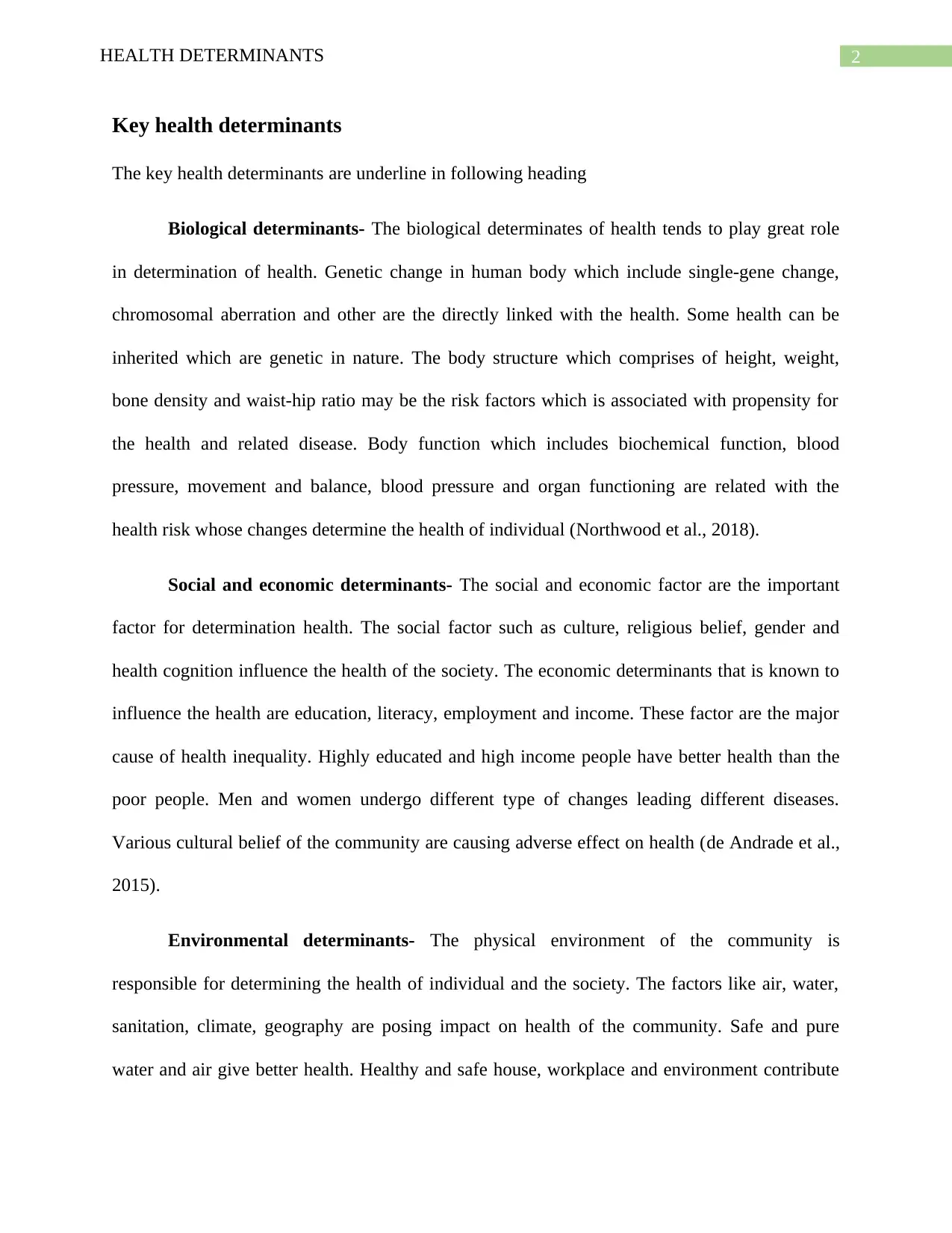
2HEALTH DETERMINANTS
Key health determinants
The key health determinants are underline in following heading
Biological determinants- The biological determinates of health tends to play great role
in determination of health. Genetic change in human body which include single-gene change,
chromosomal aberration and other are the directly linked with the health. Some health can be
inherited which are genetic in nature. The body structure which comprises of height, weight,
bone density and waist-hip ratio may be the risk factors which is associated with propensity for
the health and related disease. Body function which includes biochemical function, blood
pressure, movement and balance, blood pressure and organ functioning are related with the
health risk whose changes determine the health of individual (Northwood et al., 2018).
Social and economic determinants- The social and economic factor are the important
factor for determination health. The social factor such as culture, religious belief, gender and
health cognition influence the health of the society. The economic determinants that is known to
influence the health are education, literacy, employment and income. These factor are the major
cause of health inequality. Highly educated and high income people have better health than the
poor people. Men and women undergo different type of changes leading different diseases.
Various cultural belief of the community are causing adverse effect on health (de Andrade et al.,
2015).
Environmental determinants- The physical environment of the community is
responsible for determining the health of individual and the society. The factors like air, water,
sanitation, climate, geography are posing impact on health of the community. Safe and pure
water and air give better health. Healthy and safe house, workplace and environment contribute
Key health determinants
The key health determinants are underline in following heading
Biological determinants- The biological determinates of health tends to play great role
in determination of health. Genetic change in human body which include single-gene change,
chromosomal aberration and other are the directly linked with the health. Some health can be
inherited which are genetic in nature. The body structure which comprises of height, weight,
bone density and waist-hip ratio may be the risk factors which is associated with propensity for
the health and related disease. Body function which includes biochemical function, blood
pressure, movement and balance, blood pressure and organ functioning are related with the
health risk whose changes determine the health of individual (Northwood et al., 2018).
Social and economic determinants- The social and economic factor are the important
factor for determination health. The social factor such as culture, religious belief, gender and
health cognition influence the health of the society. The economic determinants that is known to
influence the health are education, literacy, employment and income. These factor are the major
cause of health inequality. Highly educated and high income people have better health than the
poor people. Men and women undergo different type of changes leading different diseases.
Various cultural belief of the community are causing adverse effect on health (de Andrade et al.,
2015).
Environmental determinants- The physical environment of the community is
responsible for determining the health of individual and the society. The factors like air, water,
sanitation, climate, geography are posing impact on health of the community. Safe and pure
water and air give better health. Healthy and safe house, workplace and environment contribute
⊘ This is a preview!⊘
Do you want full access?
Subscribe today to unlock all pages.

Trusted by 1+ million students worldwide
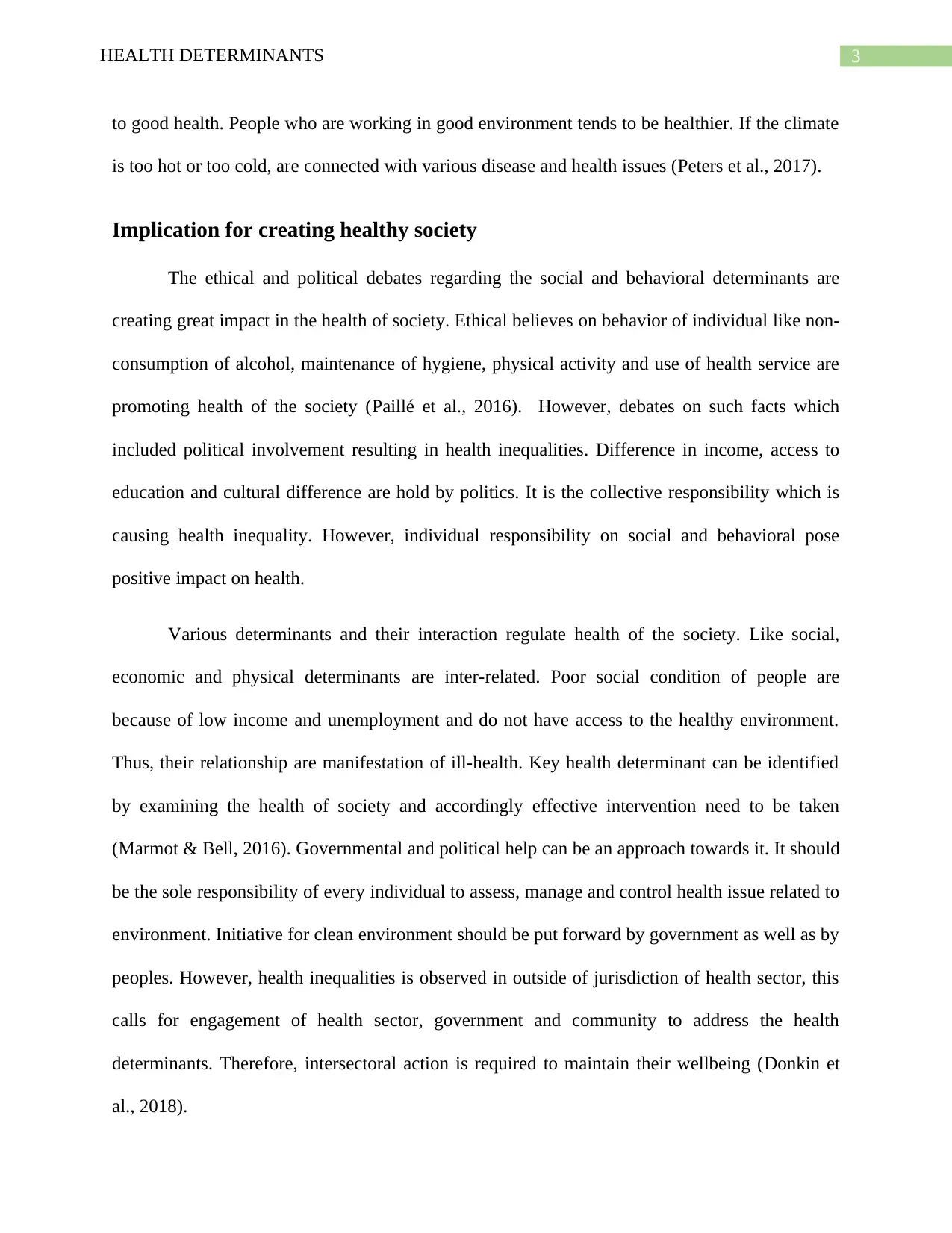
3HEALTH DETERMINANTS
to good health. People who are working in good environment tends to be healthier. If the climate
is too hot or too cold, are connected with various disease and health issues (Peters et al., 2017).
Implication for creating healthy society
The ethical and political debates regarding the social and behavioral determinants are
creating great impact in the health of society. Ethical believes on behavior of individual like non-
consumption of alcohol, maintenance of hygiene, physical activity and use of health service are
promoting health of the society (Paillé et al., 2016). However, debates on such facts which
included political involvement resulting in health inequalities. Difference in income, access to
education and cultural difference are hold by politics. It is the collective responsibility which is
causing health inequality. However, individual responsibility on social and behavioral pose
positive impact on health.
Various determinants and their interaction regulate health of the society. Like social,
economic and physical determinants are inter-related. Poor social condition of people are
because of low income and unemployment and do not have access to the healthy environment.
Thus, their relationship are manifestation of ill-health. Key health determinant can be identified
by examining the health of society and accordingly effective intervention need to be taken
(Marmot & Bell, 2016). Governmental and political help can be an approach towards it. It should
be the sole responsibility of every individual to assess, manage and control health issue related to
environment. Initiative for clean environment should be put forward by government as well as by
peoples. However, health inequalities is observed in outside of jurisdiction of health sector, this
calls for engagement of health sector, government and community to address the health
determinants. Therefore, intersectoral action is required to maintain their wellbeing (Donkin et
al., 2018).
to good health. People who are working in good environment tends to be healthier. If the climate
is too hot or too cold, are connected with various disease and health issues (Peters et al., 2017).
Implication for creating healthy society
The ethical and political debates regarding the social and behavioral determinants are
creating great impact in the health of society. Ethical believes on behavior of individual like non-
consumption of alcohol, maintenance of hygiene, physical activity and use of health service are
promoting health of the society (Paillé et al., 2016). However, debates on such facts which
included political involvement resulting in health inequalities. Difference in income, access to
education and cultural difference are hold by politics. It is the collective responsibility which is
causing health inequality. However, individual responsibility on social and behavioral pose
positive impact on health.
Various determinants and their interaction regulate health of the society. Like social,
economic and physical determinants are inter-related. Poor social condition of people are
because of low income and unemployment and do not have access to the healthy environment.
Thus, their relationship are manifestation of ill-health. Key health determinant can be identified
by examining the health of society and accordingly effective intervention need to be taken
(Marmot & Bell, 2016). Governmental and political help can be an approach towards it. It should
be the sole responsibility of every individual to assess, manage and control health issue related to
environment. Initiative for clean environment should be put forward by government as well as by
peoples. However, health inequalities is observed in outside of jurisdiction of health sector, this
calls for engagement of health sector, government and community to address the health
determinants. Therefore, intersectoral action is required to maintain their wellbeing (Donkin et
al., 2018).
Paraphrase This Document
Need a fresh take? Get an instant paraphrase of this document with our AI Paraphraser
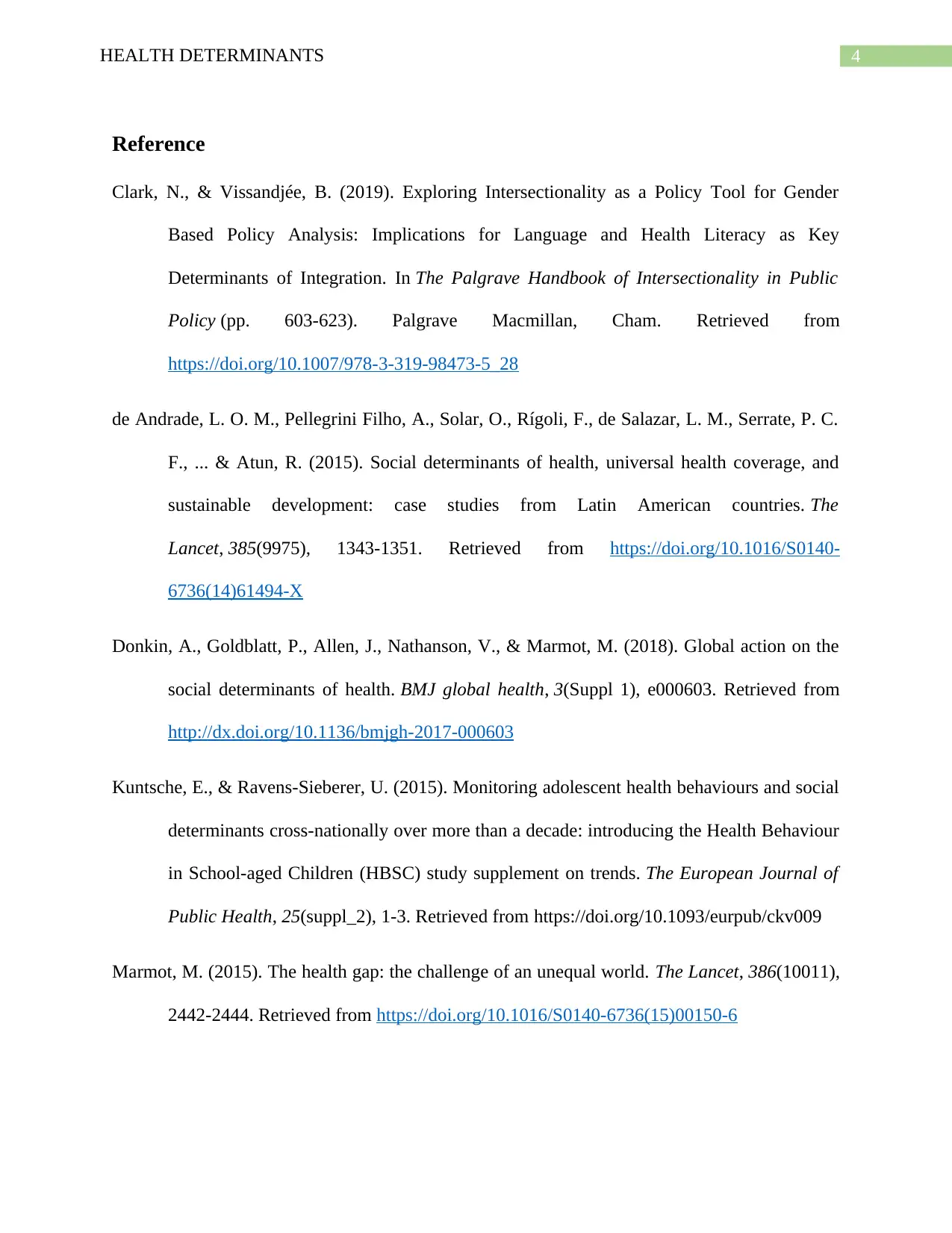
4HEALTH DETERMINANTS
Reference
Clark, N., & Vissandjée, B. (2019). Exploring Intersectionality as a Policy Tool for Gender
Based Policy Analysis: Implications for Language and Health Literacy as Key
Determinants of Integration. In The Palgrave Handbook of Intersectionality in Public
Policy (pp. 603-623). Palgrave Macmillan, Cham. Retrieved from
https://doi.org/10.1007/978-3-319-98473-5_28
de Andrade, L. O. M., Pellegrini Filho, A., Solar, O., Rígoli, F., de Salazar, L. M., Serrate, P. C.
F., ... & Atun, R. (2015). Social determinants of health, universal health coverage, and
sustainable development: case studies from Latin American countries. The
Lancet, 385(9975), 1343-1351. Retrieved from https://doi.org/10.1016/S0140-
6736(14)61494-X
Donkin, A., Goldblatt, P., Allen, J., Nathanson, V., & Marmot, M. (2018). Global action on the
social determinants of health. BMJ global health, 3(Suppl 1), e000603. Retrieved from
http://dx.doi.org/10.1136/bmjgh-2017-000603
Kuntsche, E., & Ravens-Sieberer, U. (2015). Monitoring adolescent health behaviours and social
determinants cross-nationally over more than a decade: introducing the Health Behaviour
in School-aged Children (HBSC) study supplement on trends. The European Journal of
Public Health, 25(suppl_2), 1-3. Retrieved from https://doi.org/10.1093/eurpub/ckv009
Marmot, M. (2015). The health gap: the challenge of an unequal world. The Lancet, 386(10011),
2442-2444. Retrieved from https://doi.org/10.1016/S0140-6736(15)00150-6
Reference
Clark, N., & Vissandjée, B. (2019). Exploring Intersectionality as a Policy Tool for Gender
Based Policy Analysis: Implications for Language and Health Literacy as Key
Determinants of Integration. In The Palgrave Handbook of Intersectionality in Public
Policy (pp. 603-623). Palgrave Macmillan, Cham. Retrieved from
https://doi.org/10.1007/978-3-319-98473-5_28
de Andrade, L. O. M., Pellegrini Filho, A., Solar, O., Rígoli, F., de Salazar, L. M., Serrate, P. C.
F., ... & Atun, R. (2015). Social determinants of health, universal health coverage, and
sustainable development: case studies from Latin American countries. The
Lancet, 385(9975), 1343-1351. Retrieved from https://doi.org/10.1016/S0140-
6736(14)61494-X
Donkin, A., Goldblatt, P., Allen, J., Nathanson, V., & Marmot, M. (2018). Global action on the
social determinants of health. BMJ global health, 3(Suppl 1), e000603. Retrieved from
http://dx.doi.org/10.1136/bmjgh-2017-000603
Kuntsche, E., & Ravens-Sieberer, U. (2015). Monitoring adolescent health behaviours and social
determinants cross-nationally over more than a decade: introducing the Health Behaviour
in School-aged Children (HBSC) study supplement on trends. The European Journal of
Public Health, 25(suppl_2), 1-3. Retrieved from https://doi.org/10.1093/eurpub/ckv009
Marmot, M. (2015). The health gap: the challenge of an unequal world. The Lancet, 386(10011),
2442-2444. Retrieved from https://doi.org/10.1016/S0140-6736(15)00150-6
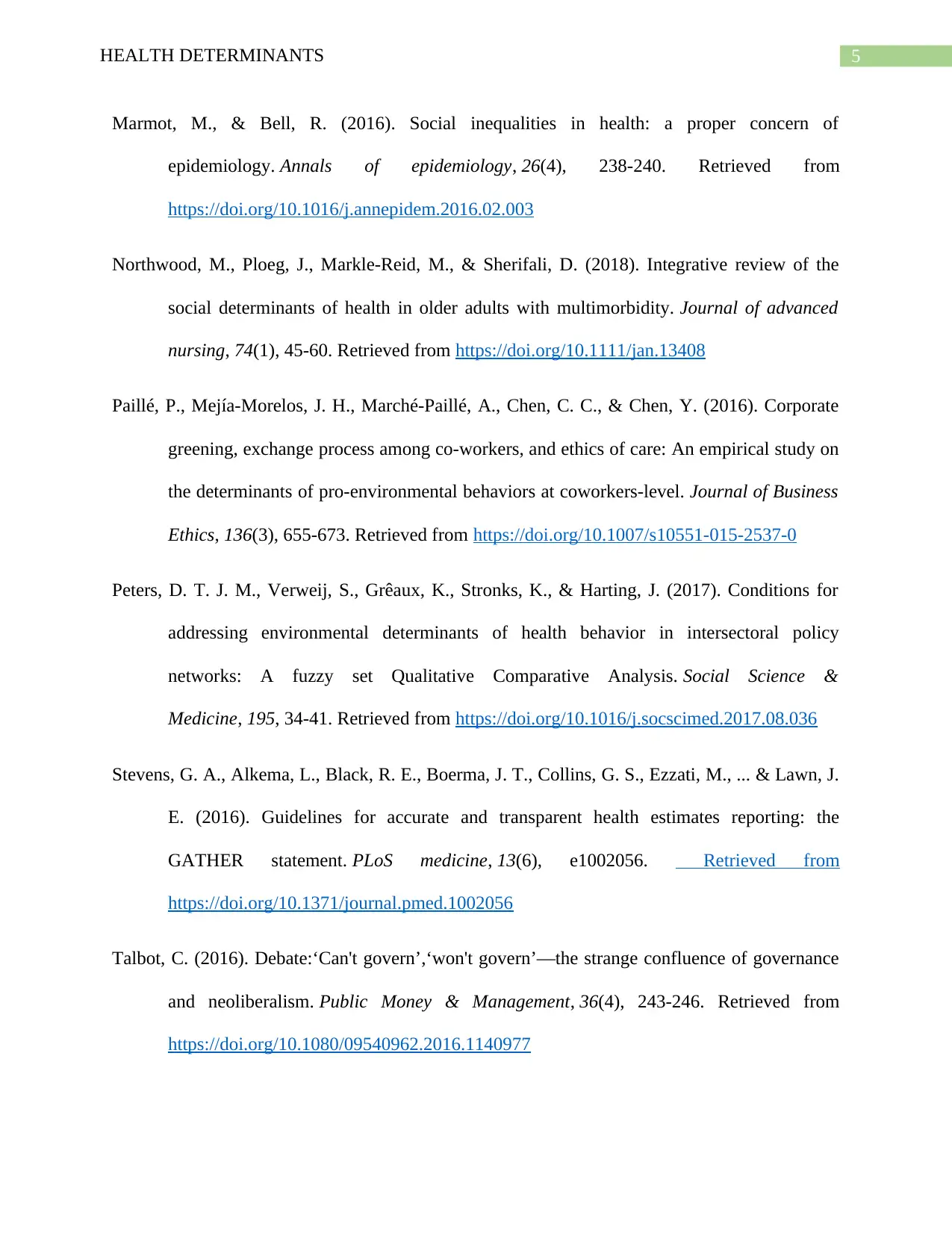
5HEALTH DETERMINANTS
Marmot, M., & Bell, R. (2016). Social inequalities in health: a proper concern of
epidemiology. Annals of epidemiology, 26(4), 238-240. Retrieved from
https://doi.org/10.1016/j.annepidem.2016.02.003
Northwood, M., Ploeg, J., Markle‐Reid, M., & Sherifali, D. (2018). Integrative review of the
social determinants of health in older adults with multimorbidity. Journal of advanced
nursing, 74(1), 45-60. Retrieved from https://doi.org/10.1111/jan.13408
Paillé, P., Mejía-Morelos, J. H., Marché-Paillé, A., Chen, C. C., & Chen, Y. (2016). Corporate
greening, exchange process among co-workers, and ethics of care: An empirical study on
the determinants of pro-environmental behaviors at coworkers-level. Journal of Business
Ethics, 136(3), 655-673. Retrieved from https://doi.org/10.1007/s10551-015-2537-0
Peters, D. T. J. M., Verweij, S., Grêaux, K., Stronks, K., & Harting, J. (2017). Conditions for
addressing environmental determinants of health behavior in intersectoral policy
networks: A fuzzy set Qualitative Comparative Analysis. Social Science &
Medicine, 195, 34-41. Retrieved from https://doi.org/10.1016/j.socscimed.2017.08.036
Stevens, G. A., Alkema, L., Black, R. E., Boerma, J. T., Collins, G. S., Ezzati, M., ... & Lawn, J.
E. (2016). Guidelines for accurate and transparent health estimates reporting: the
GATHER statement. PLoS medicine, 13(6), e1002056. Retrieved from
https://doi.org/10.1371/journal.pmed.1002056
Talbot, C. (2016). Debate:‘Can't govern’,‘won't govern’—the strange confluence of governance
and neoliberalism. Public Money & Management, 36(4), 243-246. Retrieved from
https://doi.org/10.1080/09540962.2016.1140977
Marmot, M., & Bell, R. (2016). Social inequalities in health: a proper concern of
epidemiology. Annals of epidemiology, 26(4), 238-240. Retrieved from
https://doi.org/10.1016/j.annepidem.2016.02.003
Northwood, M., Ploeg, J., Markle‐Reid, M., & Sherifali, D. (2018). Integrative review of the
social determinants of health in older adults with multimorbidity. Journal of advanced
nursing, 74(1), 45-60. Retrieved from https://doi.org/10.1111/jan.13408
Paillé, P., Mejía-Morelos, J. H., Marché-Paillé, A., Chen, C. C., & Chen, Y. (2016). Corporate
greening, exchange process among co-workers, and ethics of care: An empirical study on
the determinants of pro-environmental behaviors at coworkers-level. Journal of Business
Ethics, 136(3), 655-673. Retrieved from https://doi.org/10.1007/s10551-015-2537-0
Peters, D. T. J. M., Verweij, S., Grêaux, K., Stronks, K., & Harting, J. (2017). Conditions for
addressing environmental determinants of health behavior in intersectoral policy
networks: A fuzzy set Qualitative Comparative Analysis. Social Science &
Medicine, 195, 34-41. Retrieved from https://doi.org/10.1016/j.socscimed.2017.08.036
Stevens, G. A., Alkema, L., Black, R. E., Boerma, J. T., Collins, G. S., Ezzati, M., ... & Lawn, J.
E. (2016). Guidelines for accurate and transparent health estimates reporting: the
GATHER statement. PLoS medicine, 13(6), e1002056. Retrieved from
https://doi.org/10.1371/journal.pmed.1002056
Talbot, C. (2016). Debate:‘Can't govern’,‘won't govern’—the strange confluence of governance
and neoliberalism. Public Money & Management, 36(4), 243-246. Retrieved from
https://doi.org/10.1080/09540962.2016.1140977
⊘ This is a preview!⊘
Do you want full access?
Subscribe today to unlock all pages.

Trusted by 1+ million students worldwide
1 out of 6
Related Documents
Your All-in-One AI-Powered Toolkit for Academic Success.
+13062052269
info@desklib.com
Available 24*7 on WhatsApp / Email
![[object Object]](/_next/static/media/star-bottom.7253800d.svg)
Unlock your academic potential
Copyright © 2020–2025 A2Z Services. All Rights Reserved. Developed and managed by ZUCOL.


![Determinants of Health: Health Inequalities in the UK - [Course Name]](/_next/image/?url=https%3A%2F%2Fdesklib.com%2Fmedia%2Fimages%2Fhk%2F4ecb19a1f976477987330382c7782cdc.jpg&w=256&q=75)
